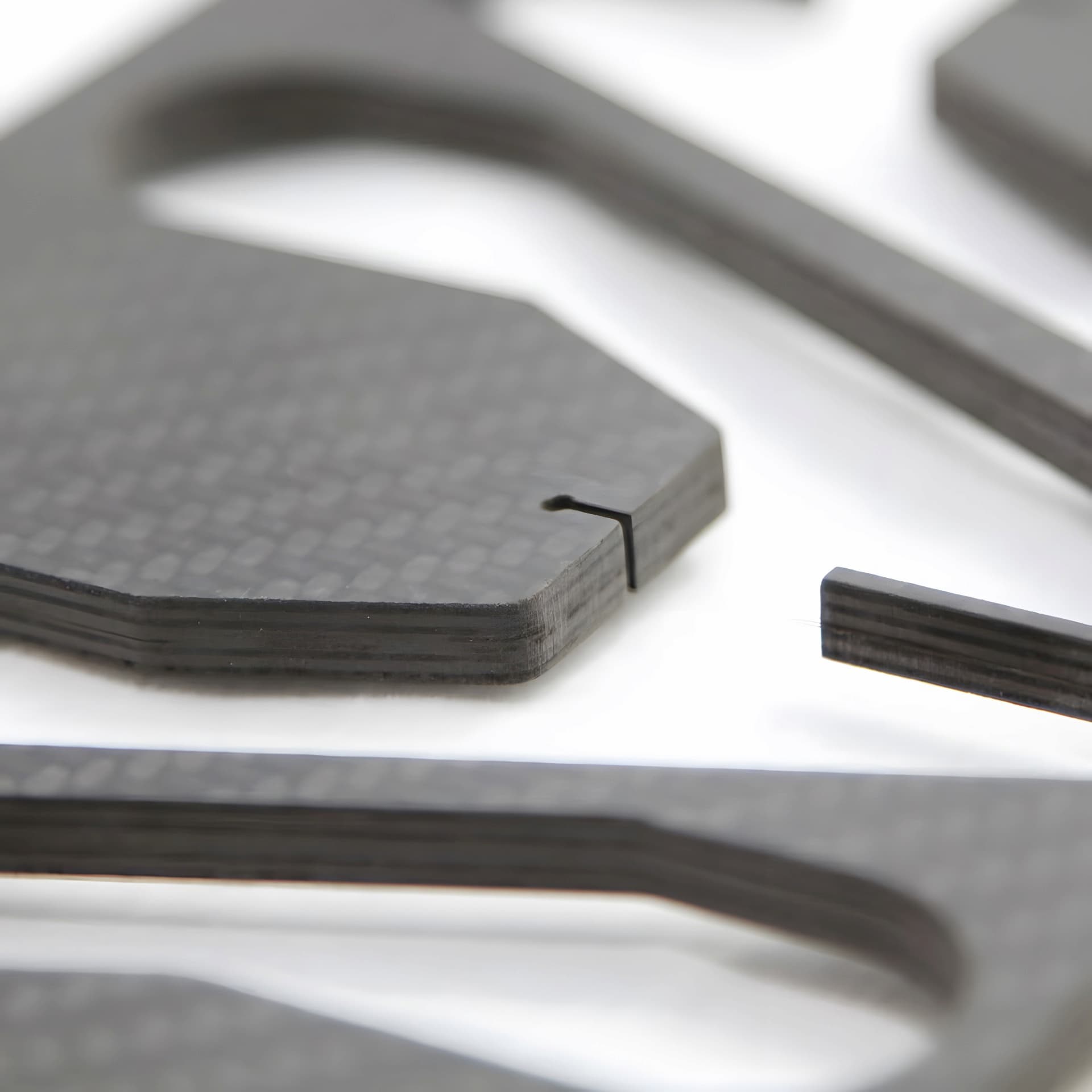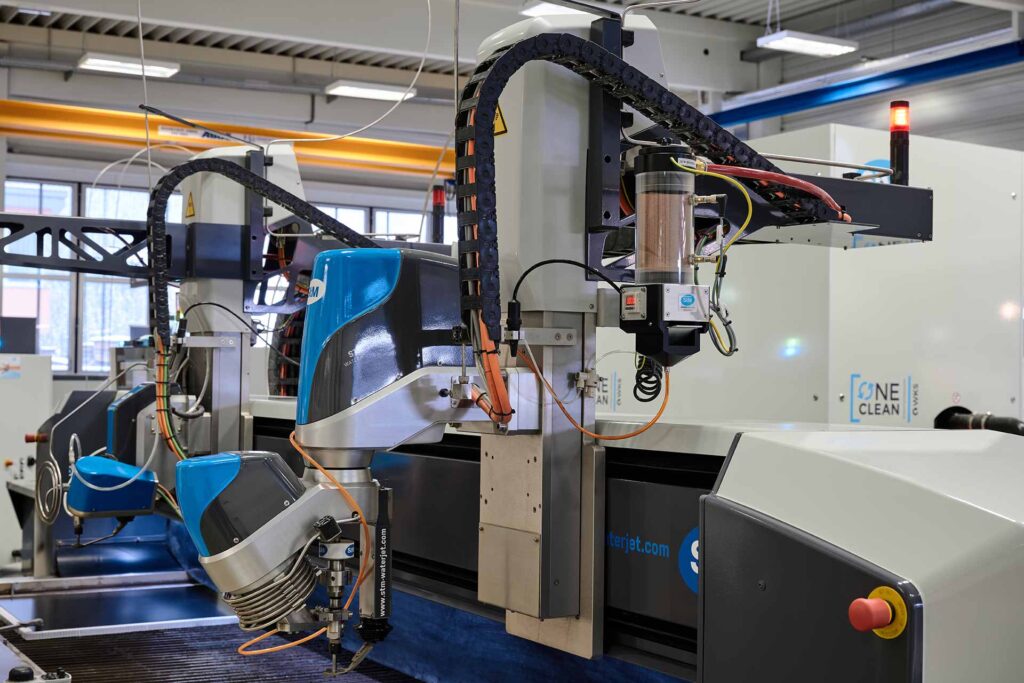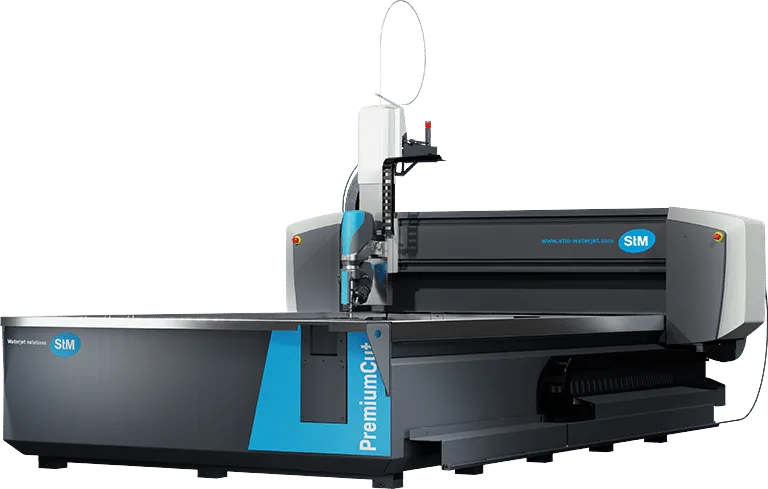Waterjet Cutting Carbon & Fiberglass
Carbon fiber (CFRP), carbon fiber reinforced plastic (GFRP) and more.
Carbon and fiberglass have become indispensable in today’s industry and are becoming increasingly important. Waterjet cutting is a cutting process that offers high precision and quality. It allows clean cuts without burrs or sharp edges. Therefore, it is particularly suitable for cutting carbon and fiberglass suitable.
A major advantage of waterjet cutting is that it is a non-thermal process with no heat generation . This keeps the delicate materials intact and prevents deformation or cracking.
In addition, the process is very gentle on the material, as the non-contact cutting process preserves the structural integrity of the carbon and glass fiber structures. It is also environmentally friendly as no harmful fumes or dust particles are produced and the cooling water can be recycled.
Table of contents
Table of contents
What kinds of carbon & glass fiber can be cut?
Waterjet cutting can precisely process various types of carbon and fiberglass materials. These include well-known materials such as carbon fiber (CFRP) and carbon fiber reinforced plastic (GFRP). CFRP, as an example, consists of carbon fibers embedded in a plastic matrix, offering high strength at low weight.
In addition to the standard materials mentioned, there are also more specialized variants of carbon and glass fiber that can be cut with waterjet cutting. These include carbon fiber scrims (CFRP fabrics), which consist of carbon fibers woven together in a specific arrangement. Glass fiber mats containing randomly oriented glass fibers are also suitable for waterjet cutting.
Waterjet cutting offers a wide range of applications for processing various carbon and fiberglass materials.
- Carbon fiber (CFRP)
- Carbon fiber reinforced plastic (GRP)
- Glass fiber reinforced plastic (GRP)
- Glass fiber reinforced concrete (GFB)
- Glass fiber reinforced plastics (GRP)
- Carbon fiber scrim (CFRP fabric)
- Carbon nanotubes (carbon nanotubes)
- Unidirectional carbon fibers
- Glass fiber mats
- Aramid fibers (Kevlar)
Want more information on cutting carbon & fiberglass with water?
5 Advantages – Waterjet Cutting Carbon & Fiberglass
Waterjet cutting of plastics offers a variety of advantages. The cut is made without thermal influence, which keeps the material properties of the plastic intact. There is no discoloration or melting edges on the cut edges, and the material retains its original quality.
The process enables high precision and fineness in cutting plastics. Even complex shapes and intricate details can be realized with great precision. In addition, waterjet cutting is extremely versatile and can process a wide range of plastics, regardless of their hardness, density or composition.
Waterjet cutting produces burr-free cut edges, which often eliminates the need for time-consuming mechanical finishing and thus saves time and money. In addition, the process is environmentally friendly as it does not produce harmful fumes, dust particles or exhaust gases. The water used can be recycled in many cases, resulting in a sustainable and resource-saving cutting solution for plastics.
Technical details
Waterjet cutting of carbon and glass fiber materials is a technically demanding process that requires careful adjustments due to the specific material properties. Abrasive waterjet cutting systems are generally used for cutting carbon fibers and carbon fiber reinforced plastic (CFRP). Here, an abrasive cutting agent is added to the water jet to increase the cutting performance. This abrasive admixture allows the waterjet to efficiently cut through the strong carbon fibers.
For glass fiber materials, such as glass fiber reinforced plastic (GFRP) and glass fiber reinforced concrete (GFRP), abrasive is usually used because glass fibers are more resistant than carbon fibers. The cutting speed, pressure and nozzle diameters are precisely adjusted according to the thickness and density of the material to achieve an optimum cutting result. The CNC-controlled technology ensures exact implementation of the desired cutting contour and enables the production of complex shapes and designs.
Modern waterjet cutting systems from STM offer a wide range of fine-tuning options and guarantee the highest precision and quality when cutting plastic.
As a rule, carbon fibers and carbon fiber reinforced plastic (CFRP) with thicknesses ranging from a few millimeters to several centimeters can be precisely cut.
- Carbon fibers (CFRP) and carbon fiber reinforced plastic: about 1 mm up to 50 mm
- Glass fiber reinforced plastic (GRP): approximately from 1 mm up to 50 mm.
- Glass fiber reinforced concrete (GFB): about 5 mm up to 100 mm or more.
Any shape cuts and bevel cuts up to 60° are possible.
The cutting accuracy is usually +/- 0.1 mm.
In waterjet cutting, the cut quality is basically divided into 5 quality levels.
- Separating cut Q1 (for blanks / semi-finished products)
- Standard cut Q3 (the most common cut)
- Fine cut Q5 (for optimum dimensional accuracy)
For waterjet cutting of carbon and glass fiber materials, the achievable cutting speeds are usually in the range of 1000 to 4000 mm per minute.
As a rule, the water pressure for cutting carbon and glass fiber is between 3600 and 4000 bar.
CNC control enables precise and repeatable cutting. The STM SmartCut cutting software offers high ease of use and functionality as well as flexibility.
References
The best advertising is known to be satisfied customers
Among our references you will find customers & partners from various fields. Among them are companies and facilities from the following industries:
- Metal industry
- Stone / Ceramics / Glass
- Plastics / foam industry
- Sealing industry
- Prototype / plant engineering
- Microwaterjet
- Educational Institutions
- Research
- Special materials
STM Product Finder
Find your work system – tailored to you
The individual wishes and requirements of our customers are the measure of all things for us. In order to be able to offer customized solutions for every requirement, we have developed a special product finder.
You tell us what you need to deliver perfect work and we put together the individual components and parts, as well as the associated software perfectly and individually. And if you are unsure, let your work material try our test cut.
FAQ – Frequently asked questions
The most frequently asked questions about waterjet cutting of carbon & fiberglass
We have collected some FAQ on the topic, waterjet cutting of carbon and fiberglass, and answered them succinctly for you.
If your question is not answered, please feel free to contact us directly.
Is waterjet cutting suitable for carbon and fiberglass materials?
Yes, waterjet cutting is particularly well suited because it is a cold-running process and generates no heat, which protects delicate materials from damage.
Which material thicknesses of carbon & glass fiber can be cut with water?
Waterjet cutting can typically cut material thicknesses from about 1 mm up to 50 mm for carbon fibers and glass fiber reinforced plastic (GFRP), while glass fiber reinforced concrete (GFRP) allows material thicknesses from about 5 mm up to 100 mm or more.
Is waterjet cutting accurate for carbon and fiberglass materials?
Yes, waterjet cutting enables high-precision cuts with tight tolerances and leaves clean cut edges without burrs.
Which industries use waterjet cutting of carbon & fiberglass?
Waterjet cutting is widely used in the aerospace, automotive, sports and recreation, medical, boat building and water sports, architecture and construction industries.
Is waterjet cutting of carbon & fiberglass environmentally friendly?
Yes, waterjet cutting does not produce toxic fumes or harmful waste because water is the main cutting medium.
What water pressure is needed to cut carbon and fiberglass with water?
As a rule, the water pressure for waterjet cutting is between 4,000 and 6,000 bar to generate the necessary cutting power.
Is waterjet cutting of carbon & fiberglass gentle on materials?
Yes, waterjet cutting is gentle on materials because the non-contact cutting process preserves the structural integrity of carbon and fiberglass materials.
How do I choose the right piercing method for waterjet cutting of carbon fibers?
This can be a challenge, but with the right piercing technique, piercing carbon fiber is no problem. Dynamic piercing, for example, is a method of moving the water jet slowly into the carbon fibers.
Does waterjet cutting of carbon fibers cause delamination?
Delamination can be prevented by using the appropriate method to pierce the carbon fibers.


